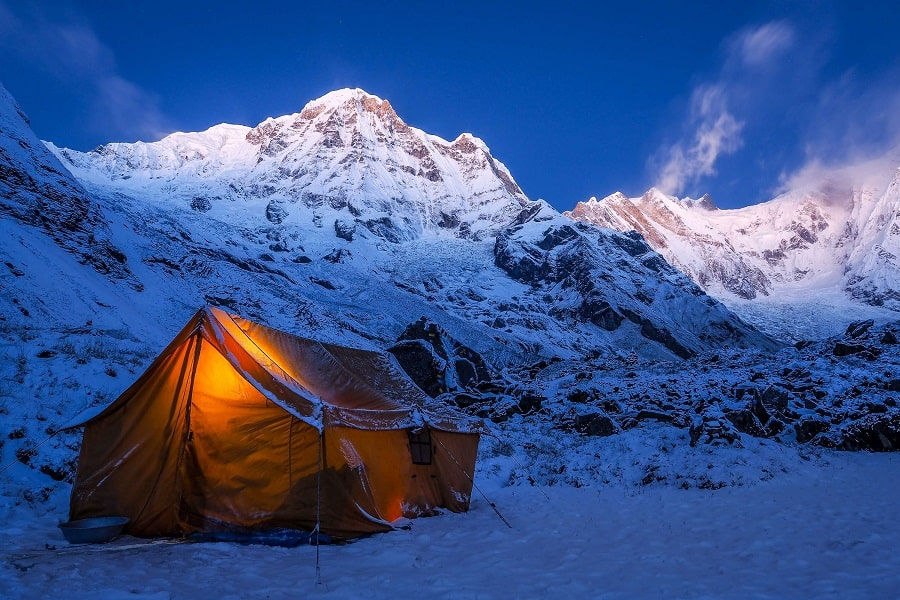Exploring local villages on the Annapurna Base Camp trail is an integral part of the trekking experience, offering a profound glimpse into the life and culture of the mountain communities. As trekkers make their way through the Annapurna Conservation Area, they pass through a series of traditional villages, each with its own unique character and charm. These villages, nestled amidst the dramatic landscapes of the Himalayas, provide not only a respite from the trek but also a chance to engage with the local way of life.
The trek begins in the lower regions where villages such as Nayapul and Tikhedhunga greet visitors with their vibrant local atmosphere. Here, trekkers are introduced to the traditional Nepali lifestyle, with stone houses and terraced fields that illustrate the harmony between people and nature. The agricultural practices in these areas are a testament to the villagers’ resilience and ingenuity, as they cultivate crops in the challenging terrain. The local residents, often warm and welcoming, offer insights into their daily routines and cultural traditions.
As the trek progresses, the villages of Ghorepani and Poon Hill ABC Trek become key highlights. Ghorepani, known for its panoramic views of the Annapurna and Dhaulagiri ranges, is a bustling hub where trekkers often stop for rest. The village is a gateway to Poon Hill, renowned for its spectacular sunrise views. In Ghorepani and nearby villages, trekkers can experience traditional hospitality and sample local dishes like dal bhat, a staple of Nepali cuisine. The vibrant bazaars and traditional architecture add to the charm, providing a rich cultural experience.
Further along the trail, the village of Chhomrong stands as a gateway to the upper reaches of the Annapurna Base Camp trek. Chhomrong is a key point where trekkers prepare for the ascent into more remote and higher altitudes. The village offers a glimpse into the lifestyle of the Gurung and Magar communities, with their distinct customs and traditions. Visitors can explore local temples, engage in conversations with residents, and learn about the cultural practices that have been preserved through generations.
Finally, as trekkers approach the Annapurna Base Camp, they pass through the villages of Bamboo and Deurali, which serve as stepping stones towards the base camp. These villages, though smaller and more remote, are essential in providing accommodation and supplies to trekkers. The simplicity of life in these high-altitude villages highlights the rugged and self-sufficient nature of the communities living in the shadow of the mighty Annapurna peaks.
Overall, exploring local villages on the Annapurna Base Camp trail offers a rich and multifaceted experience. It allows trekkers to connect with the local people, gain an understanding of their traditions, and appreciate the challenges and beauty of life in the Himalayas. Each village adds a unique dimension to the trek, making it not just a journey through stunning landscapes but also an immersion into the heart of Nepalese culture.
Introduction to Local Villages
The local villages along the Annapurna Base Camp trail offer an authentic window into the traditional lifestyle and culture of the Himalayan communities. These villages, scattered throughout the trek, are not only picturesque but also serve as vital points of interaction between trekkers and the local people. Each village is nestled amidst the stunning landscapes of the Annapurna region, showcasing a harmonious blend of natural beauty and human ingenuity. As trekkers traverse the trail, they encounter a series of villages that reflect the rich cultural tapestry and resilient spirit of the communities living in these remote areas. The journey through these villages is an opportunity to explore a way of life that has remained relatively unchanged for generations, providing a deeper understanding of the region’s heritage and traditions. The warm hospitality of the villagers and the chance to engage with their daily activities add a meaningful dimension to the trekking experience, making the exploration of these local settlements an integral part of the adventure.
Importance of Cultural Interactions
Cultural interactions along the Annapurna Base Camp trail are crucial for fostering mutual understanding and respect between trekkers and local communities. Engaging with the villagers provides trekkers with valuable insights into the customs, traditions, and daily lives of the people who call the Himalayas home. These interactions offer a unique opportunity to break down cultural barriers, learn about local practices, and gain a deeper appreciation for the way of life in the mountains. By participating in cultural exchanges, trekkers contribute to a positive relationship with the local communities, enhancing the overall trekking experience. Moreover, these interactions help preserve and promote the cultural heritage of the region, as they encourage the sharing of traditional knowledge and practices. Respectful and meaningful engagement with the villagers not only enriches the trek but also supports sustainable tourism by ensuring that local cultures are honored and preserved amidst the growing influx of visitors.
Overview of Key Villages Along the Trail
The Annapurna Base Camp trekking takes trekkers through several key villages that each offer a unique glimpse into the local way of life. Starting from Nayapul, the trek gradually ascends through picturesque villages such as Tikhedhunga and Ulleri, known for their charming stone houses and terraced fields. As the trek progresses, Ghorepani becomes a significant stop, offering stunning views of the Annapurna and Dhaulagiri ranges and serving as a base for sunrise excursions to Poon Hill. Further along, Chhomrong is a strategic village that provides a gateway to the higher altitudes of the trek. The trek also passes through Bamboo and Deurali, where the environment becomes more rugged and remote. Each of these villages has its own character and charm, with local traditions and hospitality that enrich the trekking experience. The villages serve not only as resting points but also as cultural hubs where trekkers can interact with the locals and learn about their traditions and lifestyle.
Traditional Architecture and Living Styles
The traditional architecture and living styles in the Annapurna region reflect the adaptability and resourcefulness of the local communities. The villages along the Annapurna Base Camp trail are characterized by their distinctive stone and wood construction, which is well-suited to the rugged terrain and harsh weather conditions. Traditional houses are often built from locally sourced materials such as stone, wood, and clay, featuring flat roofs and thick walls that provide insulation against the cold. The architecture is not only functional but also aesthetically integrated with the surrounding landscape, blending seamlessly with the natural environment. Inside the homes, the living spaces are simple yet practical, with a focus on communal living and warmth. The traditional lifestyle emphasizes self-sufficiency, with many households engaging in subsistence farming and animal husbandry. The way of life in these villages is deeply rooted in traditions and customs that have been passed down through generations, creating a rich cultural heritage that is both fascinating and enduring.
Local Cuisine and Culinary Experiences
Local cuisine along the Annapurna Base Camp trail offers trekkers a delightful culinary journey through traditional Nepali flavors and dishes. The villages provide an opportunity to sample a variety of local foods that are both nutritious and reflective of the region’s culinary heritage. One of the most popular dishes is dal bhat, a traditional meal consisting of lentil soup (dal) served with rice (bhat), accompanied by vegetables and pickles. This staple dish is known for its balanced flavors and sustaining properties, making it a favorite among trekkers. Additionally, many villages offer momo, steamed dumplings filled with meat or vegetables, which are a beloved snack or side dish. The local cuisine also features a range of soups, stews, and breads that highlight the use of fresh, locally grown ingredients. Dining in the teahouses and guesthouses along the trail provides an opportunity to experience the warmth of Nepali hospitality while enjoying hearty and flavorful meals that reflect the region’s agricultural practices and culinary traditions.
Festivals and Cultural Practices
Festivals and cultural practices in the Annapurna region are vibrant reflections of the local communities’ traditions and religious beliefs. The trekking route through this area offers trekkers a chance to witness or learn about a variety of traditional celebrations that are integral to the village life. Major festivals such as Dashain and Tihar, which are celebrated with great enthusiasm, mark significant occasions in the Hindu calendar. Dashain, for instance, is a time of family reunions, feasting, and rituals honoring the goddess Durga. Tihar, also known as Deepawali, involves lighting oil lamps, decorating homes, and honoring animals like crows and cows, reflecting the deep-rooted connection between the people and nature. Additionally, Buddhist festivals such as Losar, the Tibetan New Year, are observed with traditional ceremonies, dances, and offerings. These festivals are not only religious occasions but also times for community bonding and cultural expression. Observing these practices provides trekkers with a rich understanding of the local cultural fabric and the significance of these traditions in the daily lives of the villagers.
Role of Agriculture in Village Life
Agriculture plays a crucial role in the life of the villages along the Annapurna Base Camp trail, serving as the backbone of the local economy and sustenance. The terraced fields and well-tended plots that characterize the landscape are a testament to the importance of farming in these high-altitude communities. Villagers cultivate a range of crops, including rice, maize, barley, and potatoes, which are staples in their diet. The farming practices are adapted to the challenging terrain and climate, with intricate irrigation systems and crop rotation methods ensuring productivity. Livestock, such as yaks and goats, also contributes to the agricultural system by providing milk, meat, and manure. The symbiotic relationship between agriculture and daily life is evident in the way villagers manage their resources and traditions. The agricultural practices not only support local economies but also sustain cultural practices and festivals centered around the harvest. This close connection to the land underscores the resilience and ingenuity of the mountain communities in maintaining their way of life amidst the rugged landscape.
Interaction with Local Communities
Interaction with local communities along the Annapurna Base Camp trail offers trekkers a valuable and enriching experience, providing insights into the daily lives and cultural practices of the Himalayan people. Villagers are generally welcoming and eager to share their stories, traditions, and customs with visitors. Engaging in conversations, participating in local activities, and observing daily routines allow trekkers to gain a deeper appreciation of the local way of life. These interactions often take place in communal spaces such as teahouses, where trekkers can learn about local customs, try traditional foods, and participate in cultural exchanges. Such experiences foster mutual understanding and respect, creating a positive and memorable trekking experience. Furthermore, these interactions help bridge cultural gaps and contribute to sustainable tourism practices by promoting responsible and respectful behavior towards local communities. By engaging meaningfully with the villagers, trekkers not only enhance their own journey but also support and sustain the cultural and economic well-being of the communities they visit.
Handicrafts and Artisanal Products
Handicrafts and artisanal products from the villages along the 6 Days Trek to Annapurna Base Camp trail are a reflection of the region’s rich cultural heritage and craftsmanship. Local artisans create a variety of traditional goods, including hand-woven rugs, embroidered garments, and carved wooden items, which showcase their skills and cultural influences. These handicrafts are often made from locally sourced materials and incorporate traditional techniques passed down through generations. For example, the intricate patterns of Tibetan-style rugs and the colorful designs of hand-knitted woolen hats and scarves are both functional and decorative. These artisanal products are not only valuable souvenirs for trekkers but also play a crucial role in preserving traditional craftsmanship and supporting local economies. By purchasing these items, trekkers contribute to the livelihoods of local artisans and help sustain the continuation of these cultural practices. The craftsmanship seen along the trail is a testament to the creativity and skill of the local people, providing a tangible connection to the cultural richness of the Annapurna region.
Environmental Practices in Villages
Environmental practices in the villages along the Annapurna Base Camp trail reflect a deep respect for the natural surroundings and an understanding of the challenges posed by high-altitude living. The communities are actively engaged in various conservation efforts to preserve their environment and manage natural resources sustainably. Traditional practices, such as the use of organic farming methods and water conservation techniques, are integral to maintaining the ecological balance. Villages often implement waste management systems, including recycling and composting, to reduce the impact on the environment. Additionally, local initiatives, such as reforestation projects and efforts to protect wildlife, highlight the commitment of the communities to environmental stewardship. These practices are essential in preserving the pristine beauty of the Himalayas and ensuring that the region remains a viable and healthy habitat for future generations. By integrating environmental consciousness into their daily lives, the villages contribute to the broader goals of conservation and sustainable tourism, balancing human activities with the preservation of their natural heritage.
Trekking Etiquette and Guidelines
Trekking etiquette and guidelines are essential for ensuring a respectful and enjoyable experience for both trekkers and local communities along the Annapurna Base Camp trail. As trekkers navigate through the villages, it’s important to adhere to local customs and show appreciation for the cultural heritage of the region. Respectful behavior includes asking for permission before taking photographs of individuals, dressing modestly, and observing local traditions and practices. Additionally, trekkers should be mindful of the environment by following Leave No Trace principles, such as packing out all trash and minimizing the impact on natural surroundings. It’s also important to support local businesses and communities by purchasing goods and services directly from villagers, rather than from large-scale vendors. Engaging with villagers in a respectful and friendly manner, and being patient and understanding of local customs and practices, enhances the trekking experience and fosters positive interactions. By following these guidelines, trekkers contribute to a more sustainable and harmonious trekking experience that benefits both visitors and local residents.
Volunteer Opportunities in Local Villages
Volunteer opportunities in the local villages along the Annapurna Base Camp Trek trail offer trekkers a chance to give back to the communities they visit and make a positive impact. Various organizations and local initiatives provide opportunities for volunteers to engage in activities such as teaching English, assisting with community development projects, and supporting environmental conservation efforts. Volunteers may help in local schools, where they can offer educational support and resources to children, or participate in initiatives aimed at improving infrastructure and health services. Additionally, there are opportunities to assist in sustainable agriculture projects, helping villagers implement eco-friendly practices and enhance food security. By contributing their time and skills, volunteers can forge meaningful connections with the local communities and gain a deeper understanding of the challenges and needs of the region. These volunteer efforts not only provide immediate benefits to the communities but also promote long-term sustainability and development, enriching the overall trekking experience.
Impact of Tourism on Local Economies
Tourism has a significant impact on the local economies of villages along the Annapurna Base Camp trail, shaping the economic landscape in both positive and challenging ways. The influx of trekkers and climbers generates revenue for local businesses, including teahouses, guesthouses, and shops, creating job opportunities and supporting livelihoods. This economic boost helps improve infrastructure and access to services, contributing to the overall development of the region. However, the rapid growth of tourism can also lead to challenges, such as increased cost of living, environmental degradation, and pressure on local resources. Balancing economic benefits with sustainable practices is crucial to ensuring that tourism supports rather than overwhelms local economies. Efforts to manage the impact of tourism include promoting responsible travel, encouraging community involvement in decision-making, and investing in conservation and infrastructure projects. By addressing these challenges, stakeholders can help ensure that tourism contributes positively to local economies while preserving the cultural and environmental integrity of the Annapurna region.
Sustainable Tourism Practices
Sustainable tourism practices are vital for maintaining the delicate balance between visitor experiences and the preservation of the Annapurna region’s natural and cultural heritage. These practices focus on minimizing the environmental footprint of tourism, supporting local economies, and respecting cultural traditions. Key aspects of sustainable tourism include promoting eco-friendly travel practices, such as reducing waste, conserving energy, and using biodegradable products. Encouraging trekkers to follow Leave No Trace principles, such as packing out all trash and minimizing impact on trails and natural areas, helps protect the environment. Supporting local businesses and communities through direct purchases and responsible engagement fosters economic benefits and ensures that tourism revenue benefits those who live in the region. Additionally, raising awareness about cultural respect and responsible behavior helps preserve local traditions and customs. Sustainable tourism practices aim to create a positive and lasting impact, ensuring that the Annapurna region remains a vibrant and accessible destination for future generations while safeguarding its natural and cultural resources.
Conclusion: The Richness of Village Life
The richness of village life along the Annapurna Base Camp trail offers a deeply rewarding and multifaceted experience for trekkers. The blend of traditional practices, cultural interactions, and stunning landscapes creates a unique tapestry that enhances the trekking journey. Exploring the local villages provides an intimate look into the daily lives and customs of the mountain communities, highlighting their resilience, hospitality, and vibrant traditions. Engaging with the locals, participating in cultural practices, and experiencing traditional cuisine enrich the trek, offering insights into the cultural heritage and environmental stewardship of the region. The positive impact of responsible tourism, combined with efforts to support and preserve local economies and cultures, underscores the importance of respectful and sustainable travel. By appreciating the depth and diversity of village life, trekkers gain a profound understanding of the Annapurna region’s heritage and contribute to its ongoing preservation and vitality. The journey through these villages is not just a trek but a meaningful exploration of the human spirit and cultural richness that defines the heart of the Himalayas.
Stay informed with the news and updates on twinklecrest.com




